CPQ Orthopaedics (2020) 5:1Educative Article
Rules of Prophylaxis for Hips and Spine - Children and Adults - in
Points and Figures
Karski Tomasz
Professor Lecturer in Vincent Pol University, Lublin, Poland
*Correspondence to: Dr. Karski Tomasz, Professor Lecturer in Vincent Pol University, Lublin, Poland.
Copyright © 2020 Dr. Karski Tomasz. This is an open access article distributed under the Creative Commons Attribution License, which permits unrestricted use, distribution, and reproduction in any medium, provided the original work is properly cited.
Received: 16 August 2020
Published: 25 August 2020
Keywords: Hips; Spine; Scoliosis; Prophylaxis; Therapy
Abstract
In the article the author described the cardinal rules of prophylaxis and therapy for hips in small
children and in adults. In article is also presented fundamental knowledge about biomechanical
etiology of the so-called idiopathic scoliosis, classification, rules of new therapy.
Introduction
In orthopedics it is important proper diagnosis, proper therapy - in beginning period - conservative - and
if is insufficient - surgery. According my knowledge - very often the prophylaxis and ease physiotherapy
is sufficient to cure of many illnesses and deformations. So is in problem of hips and spine presented /
described in the article. All observations are based on material of many thousands of patients from years
1961 - 2020, but especially from years 1995 - 2020.
Hips and Spine - Children and Adults - Prophylaxis and Therapy in 12 Points of Descriptions
and Figures (Literature 1 - 39).
1/ Symptoms of the “Syndrome of Contractures and Deformities” (SofCD) according to Prof. H. Mau
explain many of deformations in children and adults. In this Syndrome there are asymmetries of the spine,
hips, knees, shanks, feet - in position and in movements. Smaller abduction of the left hip is the symptom
of dysplasia. Differences of movement right: left hip-smaller adduction in „extension position” of right hip -
important in the etiology of scoliosis - when child starts to stand & walk. (Fig. 1a, 1b, 1c).
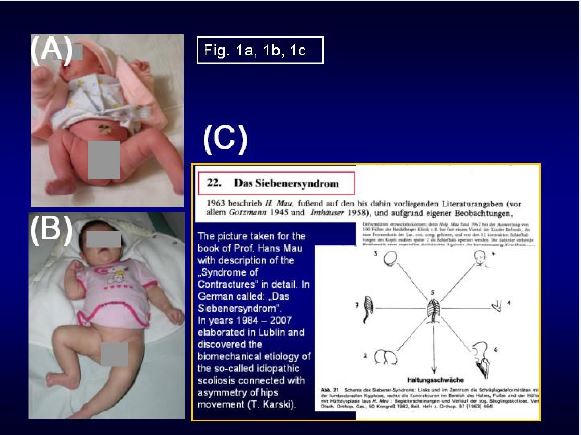
2/ Wrong way of carrying of children - without abduction of hips - its mean danger of development of
dysplasia. Such carrying is recommended by “poorly” educated or “over - educated” doctors in many countries
in Europe. Pictures taken in Poland - left and abroad - in the middle and on right (Fig. 2a, 2b, 2c).
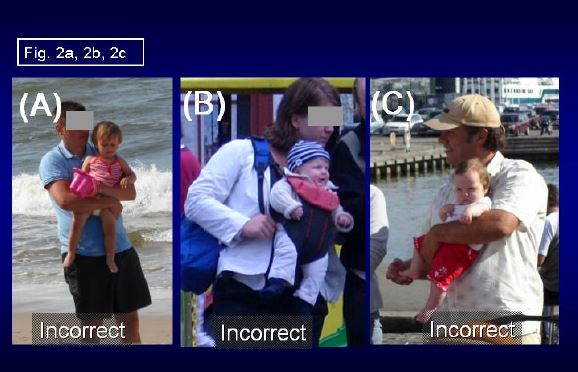
3/ The correct way of carrying a child. Its mean - prophylaxis of the hips dysplasia (A) (B) (C). Proper
therapy of the wry neck on left side (C). Permanent rotation stretching of the head to the wry neck side is
only proper method. Articles about this therapy were published in Germany and in USA [T. Karski 1991
& 2017]. (Fig. 3a, 3b, 3c).
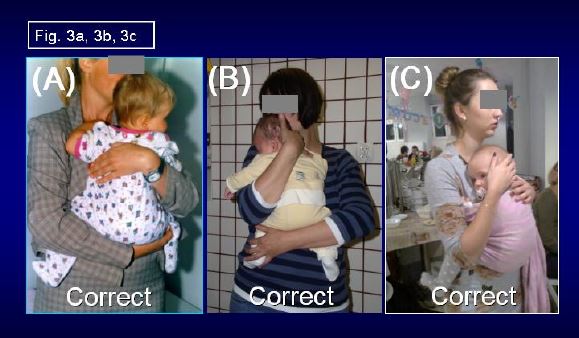
4/ (A) Example of advanced arthrosis in the left hip with heavy symptoms - pain, limping. This patient was
in childhood never treated. (B) Both hips pain - in right hip because of permanent standing ‘at ease’ on the
right leg. (Fig. 4a, 4c, 4c, 4d)
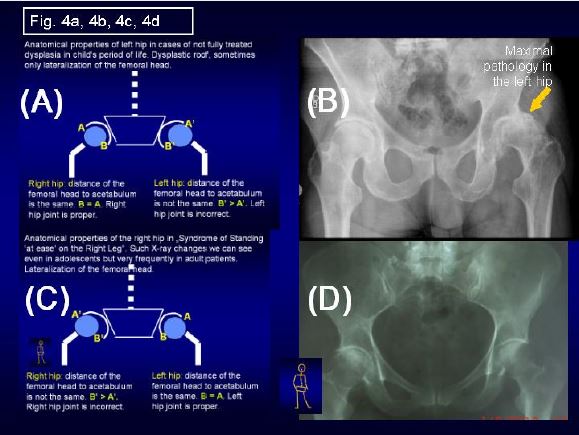
5/ Importance of standing. Methods of physiotherapy as prophylaxis of arthrosis of the hips. A special form
of standing and sitting should be introduced at the age of 45 - 50. Standing in abduction and in internal
rotation changes the loading on the femoral heads, enables regaining internal rotation. Such standing -
should be perform - every day in every situation over many years (Fig. 5a, 5b, 5c, 5d).
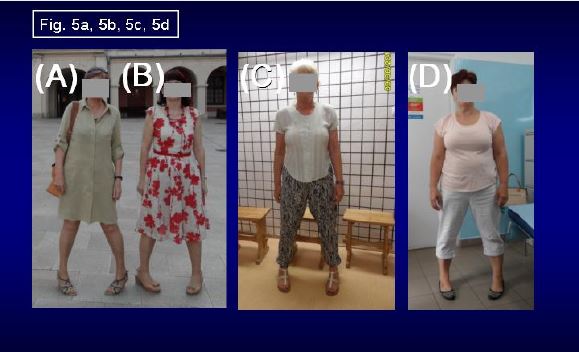
6/ Importance of sitting. On pictures / figures is proposed the methods of physiotherapy as prophylaxis
of arthrosis of the hips. A special form of standing and sitting should be introduced at the age of 45 - 50.
Sitting - in internal rotation, what increases the range of this movement. Patients should sit in this position
every day in every situation. Sport in the form of “Nordic walking” is also very important (Fig. 6a, 6b, 6c, 6d).
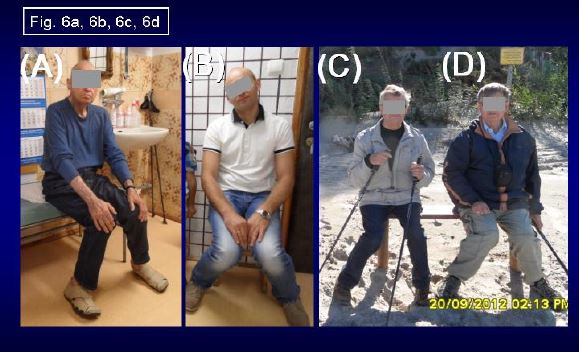
7/ Explanation of developmental of so-called idiopathic scoliosis. Important is range of adduction of the
hips and type of scoliosis. Influence: „standing ‘at ease’ on right leg” and „gait”. 3 groups & 4 types. Groups:
A/ Gait & Standing - “S” scoliosis, 3D - stiff spine, two curves, rib hump on right side of thorax.
B/ Standing - “C” and “S” scoliosis, 2D or 3D. Flexible spine. In “S” scoliosis in etiology additionally laxity
of joints or / and incorrect previous therapy.
C/ Gait - “I” scoliosis 2D or 3D - stiff spine, No or small curves. In 2004 included to scoliosis group / type
in Lublin classification (Fig. 7a, 7b, 7c).
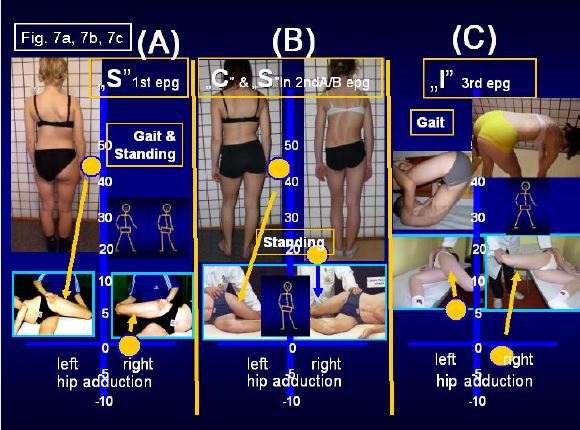
8/ Example of “S” scoliosis in 1st group / type. Range of adduction of hips in 1st type of scoliosis presented
on picture. Two curves. Gibbous. Stiff spine (Fig. 8).
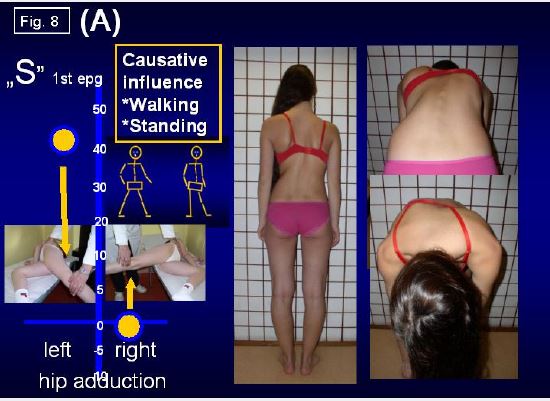
9/ Example of “C” or “S” scoliosis in 2nd group / type. Range of adduction of hips in 2nd/A “C” and in 2nd/B
“S” type of scoliosis presented on picture. Flexible spine (Fig. 9).
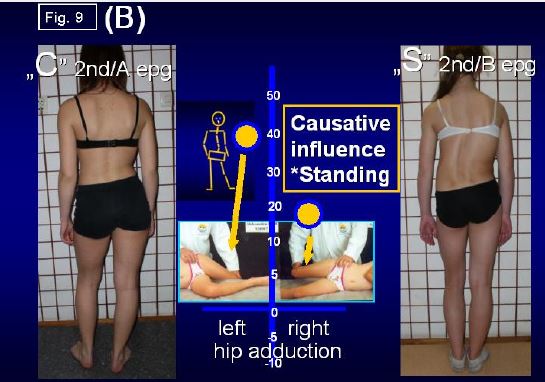
10/ Example of “I” scoliosis in 3rd group / type. Range of adduction of hips in 3rd “I” type of scoliosis
presented on picture. No curves or small. Stiffness of spine (Fig. 10).
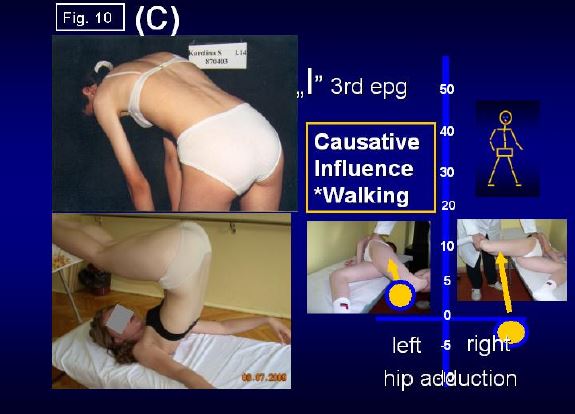
11/ Example of wrong and harmful exercises (A) (B). After such incorrect therapy and in this case (C) also
surgery - iatrogenic deformity, big curves, big rib hump and maximally stiff spine (Fig. 11).
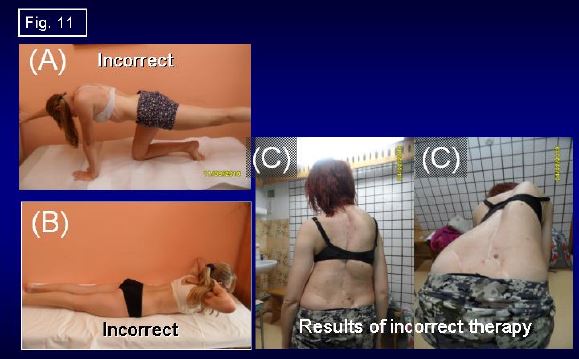
12/ Stretching exercises are proper for scoliosis. Important standing only on the left leg & sport - karate,
taekwondo, aikido, kung fu, yoga from first years of child’s life (Fig. 12).
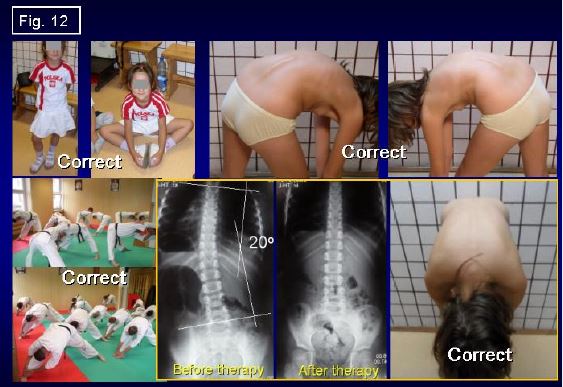
Discussion and Conclusions
Many of older ill people have the symptoms of hips arthrosis, many of youths persons have scoliosis.
The prophylaxis of dysplasia of hips is very important, because it is the first step in prevention of hip
arthrosis in adults. Proper carrying of children is very important - but till now not sufficient “admitted and
understandable” by many parents in the world, mostly in Europe.
Already 25 years I present the biomechanical etiology of the so-called idiopathic scoliosis. The explanation
in Poland is also “not sufficient admitted and not understandable”. I hope - this article will “one important
input / step in new knowledge” of both problems and will be transmitted from Canada to other countries.
Bibliography
- Burwell, G., Dangerfield, P. H., Lowe, T. & Margulies, J. (2000). Spine. Etiology of Adolescent Idiopathic Scoliosis: Current Trends and Relevance to New Treatment Approaches. Hanley & Belfus, Inc, Philadelphia, 14(2), 324.
- Dangerfield, P. H., Dorgan, J. C., Scutt, D., Gikas, G. & Taylor, J. F. (1995). Stature in Adolescent Idiopathic Scoliosis (AIS). 14 Meeting EPOS, Brussels, Papers and Abstracts, (p. 210).
- Green, N. E. & Griffin, P. P. (1982). Hip dysplasia associated with abduction contracture of the contralateral hip. J.B.J.S., 64(9), 1273-1281.
- Gruca, A. & Tylman, D. (1995). Patomechanika bocznych skrzywień kręgosłupa, Wydawnictwo Severus, Warszawa, Seiten 167.
- Heikkilä, E. (1984). Congenital dislocation of the hip in Finland. An epidemiologic analysis of 1035 cases. Acta Orthop. Scandinavica, B., 55(2), 125-129.
- Hensinger, R. N. (1979). Congenital dislocation of the hip. Clinical Symp., 31, 270.
- Howorth, B. (1977) The etiology of the congenital dislocation of the hip. Clin. Orthop., 29, 164-179.
- Karski, T. (1996). Kontrakturen und Wachstumstörungen im Hüft- und Beckenbereich in der Ätiologie der sogenannten “idiopatischen Skoliosen” - biomechanische Überlegungen. Orthopädische Praxis, 32(3), 155-160.
- Karski, T. (2002). Etiology of the so-called “idiopathic scoliosis”. Biomechanical explanation of spine deformity. Two 272 groups of development of scoliosis. New rehabilitation treatment. Possibility of prophylactics, Studies in 273 Technology and Informatics. Research into Spinal Deformities, 4(91), 37-46.
- Karski, T., Kalakucki, J. & Karski, J. (2006). Syndrome of contractures (according to Mau) with the abduction contracture of the right hip as causative factor for development of the so-called idiopathic scoliosis. Stud Health Technol Inform., 123, 34-39.
- Karski Tomasz (2010). Factores biomechanicos en la etiologia de las escoliosis dinominadas idiopaticas. Nueva 282 clasificacion. Nuevos test clinicos y nueavo tratamento conservador y profilaxis. Cuestiones de Fisioterapia, 39(2), 85-152.
- Karski Tomasz (2010). Biomechanical Etiology of the So-called Idiopathic Scoliosis (1995-2007). New Classification: 285 Three Groups, Four Sub-types. Connection with Syndrome of Contractures. Pan Arab J. Orth. Trauma., 14(2), 287.
- Karski Tomasz (2013). Biomechanical Etiology of the So-called Idiopathic Scoliosis (1995 - 2007). Three Groups and 288 Four Types in the New Classification. Journal of Novel Physiotherapies, S2, 290.
- Karski Jacek, Tomasz Karski (2013). So-Called Idiopathic Scoliosis. Diagnosis. Tests Examples of Children Incorrect 291 Treated. New Therapy by Stretching Exercises and Results. Journal of Novel Physiotherapies, 3-2, 293.
- Karski Tomasz (2014). Biomechanical Aetiology of the So-Called Idiopathic Scoliosis. New Classification (1995 - 2007) in Connection with “Model of Hips Movements”. Pages 12. Global Journal of Medical Research H: Orthopedic and Musculoskeletal System, 14(3).
- Karski Tomasz (2014). Biomechanical Etiology of the So-called Idiopathic Scoliosis (1995 - 2007) - Connection with “Syndrome of Contractures” Fundamental Information for Pediatricians in Program of Early Prophylactics. Surgical Science, 5, 33-38.
- Karski Tomasz, Karski Jacek (2015). “Syndrome of Contractures and Deformities” according to Prof. Hans Mau as Primary Cause of Hip, Neck, Shank and Spine Deformities in Babies, Youth and Adults. American Research Journal of Medicine and Surgery, 1(2).
- Karski Tomasz & Jacek Karski (2015). Biomechanical etiology of the so-called Idiopathic Scoliosis (1995 - 2007). Causative role of “gait” and “permanent standing ‘at ease’ on the right leg”. New classification. Principles of new therapy and causal prophylaxis. Canadian Open Medical Science & Medicine Journal, 1(1), 1-16.
- Karski Jacek MD PhD, Prof. Tomasz Karski MD PhD, Jarosław Pyrc MD PhD & Dr Małgorzata Kulka (2016). Deformations of the feet, knees, hips, pelvis in children and adults with minimal brain dysfunction. causes. treatment. Prophylaxis. Locomotors System, 23, 2.
- Karski Tomasz (2017). Physiotherapy- Correct, or Incorrect, Based on ‘Wrong Principles of Treatment’. Example for Spine, Hip, Knee, Shank and Feet, Crimson Publishers, USA.
- Karski Tomasz, Jacek Karski, Klaudia Karska, Katarzyna Karska & Honorata Menet (2018). Pediatric Prophylaxis Program of Motor System Deformations and Illnesses in Children. Problems of Spine, Hips, Knees and Feet. EC Paediatrics., 7(7), 704-714.
- Karski Tomasz, Jacek Karski, Katarzyna Karska, Klaudia Karska & Honorata Menet (2018). Prophylactic Rules for Newborns, Babies, Children and Adults in problems of Hip, Knee, Shank, Feet and Spine. Ortho Res Online J., 2(1), 110-112.
- Karski Tomasz & Jacek Karski (2016). Bóle krzyża - problem neurologiczno - ortopedyczny. Objawy. Przyczyny. Leczenie. Back pain - neurology-orthopedic problems. Clinic, causes, therapy and prophylaxis. Postępy Neurologii Praktycznej., 9-16.
- Karski Jacek & Karski Tomasz (2016). “Imperfect hips” As a Problem at an Older Age. Early and Late Prophylactic Management before Arthrosis. Jacobs Journal of Physiotherapy and Exercises, 2(1), 015.
- Karski Tomasz (2018). Biomechanical Aetiology of the So-called Adolescent Idiopathic Scoliosis (AIS). Lublin Classification (1995-2007). Causative Influences Connected with “Gait” and “Standing ‘at ease’ on the Right Leg”. Journal of Orthopaedics and Bone Research (USA), Scholarena, 1(1), 1-10.
- Karski Tomasz (2019). Biomechanical Etiology of the So-Called Idiopathic Scoliosis, Connection with “Syndrome of Contractures and Deformities”, Role of Gait and Standing ‘At Ease’ On the Right Leg in the Development of Spine Deformity, New Treatment, Causal Prophylactics. International Journal of Orthopaedics Research, 5.
- Karski Tomasz (2019). Biomechanical Etiology of the So-called Idiopathic Scoliosis (Adolescent Idiopathic Scoliosis [AIS]). New Classification Rules of Therapy and Prophylaxis. Nursing and Health Care Journal, 4(1), 143.
- Lowe, T. G., Edgar, M., Margulies, J. Y., Miller, N. H., Raso, V. J., Reinker, K. A., et al. (2000). Etiology of idiopathic scoliosis: current trends in research. J. Bone Joint Surg. Am., 82(8), 1157-1168.
- Malawski Stefan (1992). Epidemiologia skoliozy, Postępy Polskiej Spondyloortopedii, stron 5, 5.
- Malawski Stefan (1992). Własne zasady leczenia skolioz niskostopniowych, Postępy Polskiej Spondyloortopedii, 2, (pp. 1-2).
- Malawski, S. (1994). Własne zasady leczenia skolioz niskostopniowych w świetle współczesnych poglądów na etiologię i patogenezę powstawania skolioz. Chir. Narz. Ruchu i Ortop. Pol., 59(3), 189-197.
- Mau, H. (1979). Zur Ätiopathogenese von Skoliose, Hüftdysplasie und Schiefhals im Säuglinsalter. Zeitschrift f. 294 Orthop., 5, 601-605.
- Mau, H. (1982). Die Atiopatogenese der Skoliose, Bücherei des Orthopäden, Band 33. Enke Verlag Stuttgart, 1, 296-297.
- Normelly, H. (1985). Asymmetric rib growth as an aetiological factor in idiopathic scoliosis in adolescent girls, 298. Stockholm, 1-103.
- Rąpała, K. & Tylman, D. (1995). Patomechanika bocznych skrzywień kręgosłupa, Wydawnictwo Severus. Warszawa, 167.
- Stokes, I. A. F. (1999). Studies in Technology and Informatics, Research into Spinal Deformities 2, 59., IOS Press 1999, Amsterdam, Berlin, Oxford, Tokyo, Washington DC, 1-385.
- Sevastik, J. & Diab, K. (1997). Studies in Technology and Informatics, Research into Spinal Deformities 1, 37., IOS 300 Press 1997, Amsterdam, Berlin, Oxford, Tokyo, Washington, DC 1-509.
- Tylman, D. (1995). Patomechanika bocznych skrzywień kręgosłupa, Wydawnictwo Severus, Warszawa, 167.
- (2006) www.ortopedia.karski.lublin.pl












